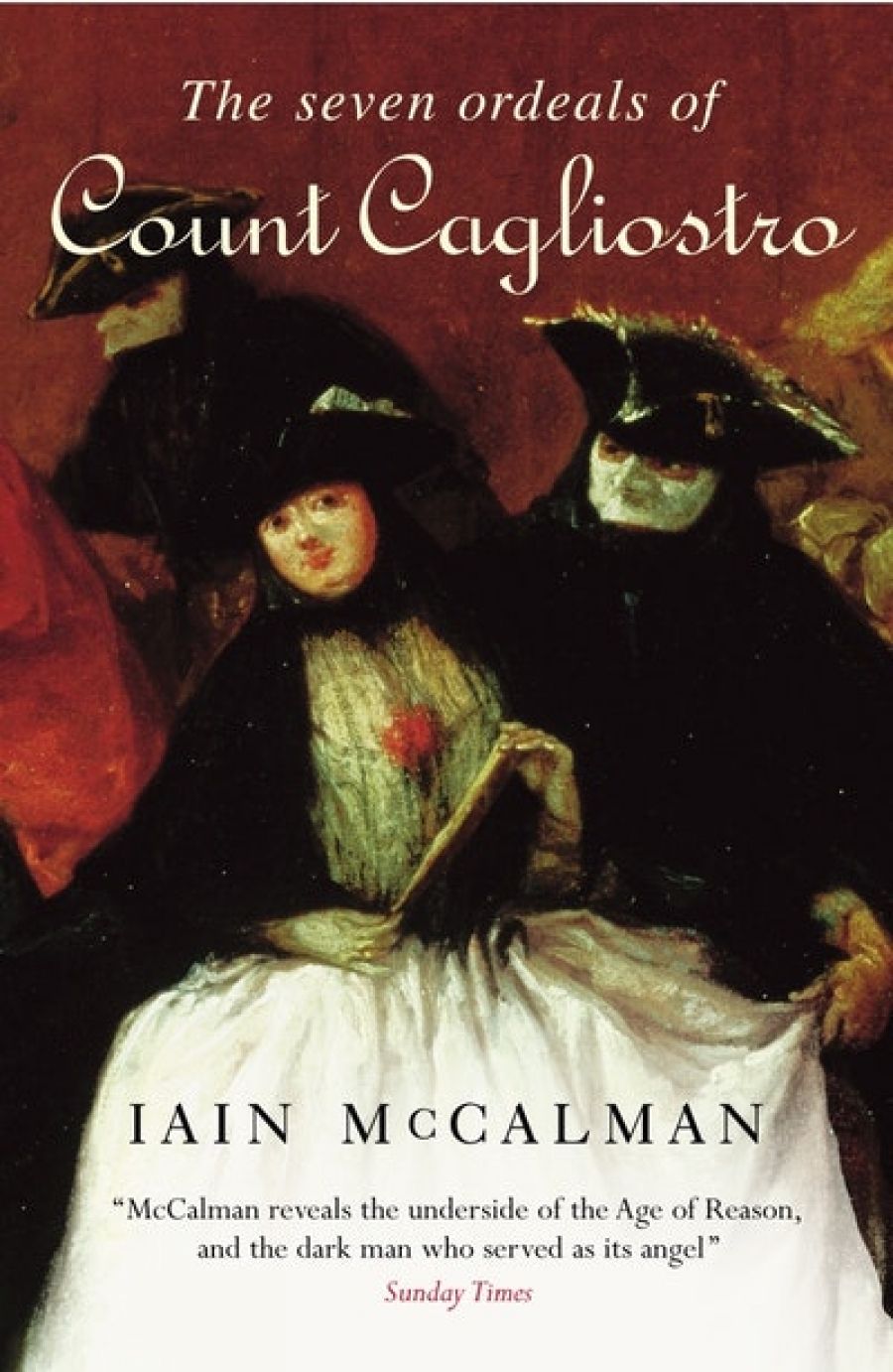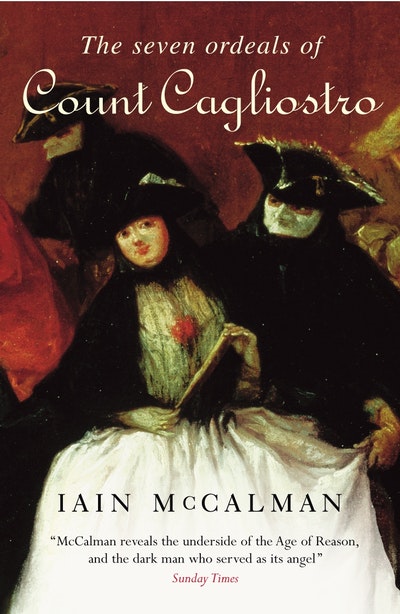
- Free Article: No
- Contents Category: Biography
- Review Article: Yes
- Article Title: The Crook with a Great Soul
- Online Only: No
- Custom Highlight Text:
You haven’t heard of Count Cagliostro? Well, chances are if HarperCollins has anything to do with it, you will. Iain McCalman’s book comes with enthusiastic endorsements from Simon Winchester, Peter Conrad and Peter Gay. And it must be said that there is a sense in which the Count – ‘the greatest enchanter of the eighteenth century’, as McCalman salutes him – is alive and well: a Google search on the Internet brings up more than 4000 results. Indeed, the starting point for McCalman’s skilfully entertaining account of Cagliostro’s career as magician, alchemist, healer and Freemason is the puzzle of this after-life, or what he calls Cagliostro’s ‘ascension into culture’. The irony is that this book is likely to ensure that the enchanter casts his spell on a new audience. For it is an extraordinary tale.
- Book 1 Title: The Seven Ordeals of Count Cagliostro
- Book 1 Subtitle: The Greatest Enchanter of the Eighteenth Century
- Book 1 Biblio: Flamingo, $29.95 pb, 384 pp
- Book 1 Cover Small (400 x 600):

- Book 1 Cover (800 x 1200):

Born Guiseppe Balsamo in Palermo in 1743, and educated in a Catholic seminary for orphaned children, he briefly became a novice in a monastery before taking to the streets, and then the world. Having acquired some convenient skills in chemistry and drawing, and, courtesy of the monastery, a knowledge of ancient Egyptian and Greek magical theory, Balsamo developed a career that took him the length and breadth of Europe. Reinventing himself as Count Cagliostro, he became a controversial celebrity. The drama of his life has a cast of eighteenth-century stars: Casanova, Catherine the Great and Marie-Antoinette all have roles. The part that Cagliostro played in the ‘diamond necklace affair’, which presaged the collapse of the ancien régime, allowed him to insinuate himself into the mythology of the French Revolution. William Blake saw him, McCalman tells us, as ‘a figure of countercultural resistance’, while for Thomas Carlyle his success was a symptom of Europe’s social decadence that belied any claims for the late eighteenth century being an age of reason.
What did Cagliostro have going for him? Carlyle, perhaps drawing on Houdon’s bust of the Count, sees only the corrupt façade of an impostor:
A fat, snub, abominable face; dew-lapped, flat-nosed, greasy, full of greediness, sensuality, oxlike obstinacy: a forehead impudent, refusing to be ashamed; and then two eyes turned up seraphically languishing, as in divine contemplation and adoration …
This was ‘perhaps the most perfect quack-face produced by the eighteenth century’. Compare this with the description offered by Baroness Henriette-Louise d’Oberkirch, ‘a fine-boned Protestant aristocrat’, McCalman assures us, who only just managed to avoid falling under Cagliostro’s spell. His eyes ‘were indescribable, with supernatural depths – all fire and yet all ice’. His voice caressed ‘like a trumpet veiled in crêpe’, while his haughty manner ‘at once attracted and repulsed you, he frightened you and at the same time inspired you with an insatiable curiosity’. Many others attested to the power of his presence, the effect being heightened by an often-dramatic unpredictability of behaviour.
Cagliostro acquired a very handy partner in Seraphina, ‘a ravishing fourteen-year-old’ when he married her in Rome. The Count was totally besotted with his young wife, but this did not prevent him from encouraging her to use her gift of beauty to advance their joint interests. Seraphina became an essential part of the Cagliostro project: she would also, in the end, be the agent of its demise.
Perhaps the most fascinating aspect of Cagliostro’s career is his involvement with Freemasonry. McCalman depicts Cagliostro as initially joining a lodge in London as ‘a needed diversion’, but he soon began to appreciate how he could use Freemasonry for his own purposes. His lodge adhered to the Rules of the Strict Observance Rite, which, although originating as a Scottish breakaway group with Stuart sympathies, had found fertile ground in parts of Europe, developing, along the way, a penchant for Rosicrucian occultism. And there was the added attraction that the lodge he encountered was ‘a lodge of adoption’, which included women in a parallel organisation, so that Seraphina could be co-opted to the cause. If you have ever wondered how women managed to infiltrate Sarastro’s lodge in The Magic Flute, considering it, as I did, a case of operatic licence, stand corrected: Mozart was inspired by Cagliostro when he created the High Priest.
Not only did this brand of Freemasonry suit Cagliostro right down to the ground, it also provided him with a network of contacts that he could exploit in his European travels. In St Petersburg, however, he seriously miscalculated in his attempt to win the favour of Catherine the Great, not appreciating that she, like the Church of Rome, was opposed to Freemasonry, seeing it as potentially subversive of social and political order. He and Seraphina were forced to move on, as they often were when their luck ran out, but there always seemed to be fresh fields to conquer.
While Cagliostro was pursuing his Masonic odyssey – along the way effortlessly assuming the identity of the ‘Great Copt’, a legendary high priest of ancient Egyptian Freemasonry – he was also practising his considerable skills as a healer. Often, when he descended on a city, he would cause a stir by opening a healing clinic for the poor where he freely dispensed his remedies. His apparent success would then attract the attention of the afflicted rich who, when cured, would become useful patrons. McCalman acknowledges Cagliostro’s achievement in healing, pointing out that, by the standards of the day, his ‘medical knowledge seemed as much “scientific” as magical’. He was also adept at picking up on new fads, such as Mesmer’s use of magnetic forces, which fitted nicely with his own conduct of spiritualist séances.
His spectacular career came to an end in Rome. Seraphina, tired of their peripatetic existence, and having also returned to the Church, dobbed him in to the Inquisition, which tried him for heresy. Cagliostro was dispatched to spend the rest of his days in a remote prison fortress, the authorities increasingly concerned that French revolutionaries might seek to engineer his escape. In this Gothic hell-hole, he seemed to descend into madness, while retaining an extraordinary capacity to unnerve and alarm his gaolers. He died in 1795; two years later, the revolutionary armies took the fortress. Legend has it that the officers of the Polish legion ordered his remains dug up: ‘picking up his whitened skull, they filled it with wine and toasted his memory.’ It was an appropriately Gothic gesture, but it could also be taken to symbolise the resurrection of the enchanter.
There is a sense in which Cagliostro defies biography. His life was a performance and perhaps only with Seraphina (who, incidentally, was an embarrassment to Rome and was banished to a convent) did he allow the mask to drop. Yet McCalman is able to present the performance with a masterful deployment of the available sources. Little attempt is made to explain Cagliostro in psychological terms. Rather, the story of his life is told in a way that the Count himself might well have approved, cunningly organised in a symmetry of ‘seven ordeals’, the number itself having an appropriate magical and mystical resonance. At one level, it takes on the character of a ‘ripping yarn’, or perhaps an eighteenth-century road movie, but we are always conscious of the tastes and susceptibilities of an increasingly troubled society, which made his career possible. And here, of course, McCalman’s earlier work on the radical underworld of this era serves him well.
The Seven Ordeals of Count Cagliostro is written with earthy economy: there is a certain cool swagger to the narrative. One character is described as seeing Cagliostro and his crew as ‘these scumbags’, while one of the Count’s colleagues is ‘a theosophical groupie’. Seraphina is even pilloried by her critics for trying ‘to vamp every man she met’.
McCalman confesses that he feels ‘a strange affinity’ with Cagliostro, and wonders whether this might be because, having spent his first eighteen years in Africa, he shares with the Count ‘a bogus African identity’. This strikes me as fanciful, but there can be no doubt that Cagliostro has found in McCalman a worthy interpreter and advocate. At the end, however, he seems almost reluctant to pronounce judgment, as if the performance itself should be sufficient, and, returning to the birthplace of Giuseppe Balsamo in Palermo, takes brief refuge in the popular image there of the enchanter as ‘a flawed local hero’. One of his Sicilian friends puts it this way: ‘Cagliostro may have been a crook, but he had a great soul.’


Comments powered by CComment